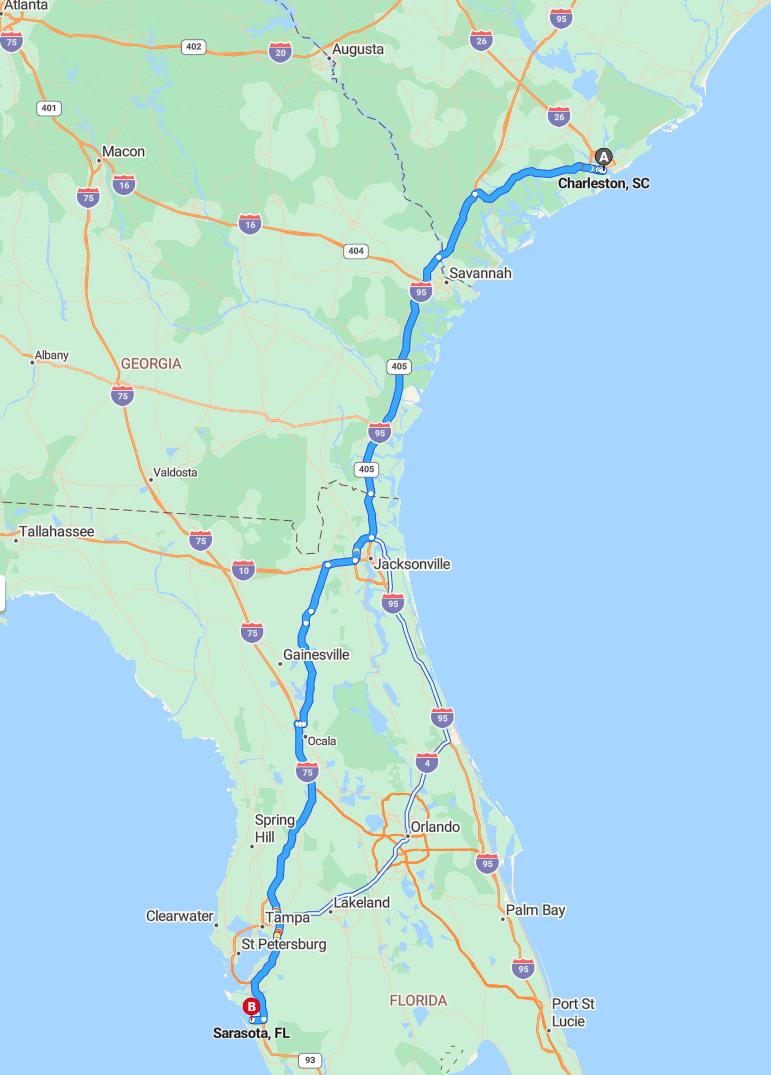Distance and estimated driving time
The drive from Charleston to Sarasota covers approximately 488 miles via I-95 S, offering a scenic and straightforward route. Estimated travel time is around 7 hours and 48 minutes, making it a manageable trip with proper planning. Travelers should consider potential traffic, especially near major cities, to ensure timely arrival. Preparing for rest stops and fuel breaks can help optimize the journey and enhance overall driving comfort.
Driving route
Traveling from Charleston to Sarasota offers a scenic journey through the southeastern United States, featuring a mix of historic cities and vibrant coastal towns. Starting in Charleston, travelers can enjoy the city's charming architecture and rich history before heading to Savannah, known for its beautiful parks and historic district. Continuing south, Jacksonville provides a lively cultural scene and scenic riverfront, followed by Gainesville's college-town atmosphere. As the route progresses through Ocala and Tampa, travelers encounter lush landscapes and bustling urban areas, ultimately arriving at St. Petersburg and Sarasota's stunning beaches and cultural attractions. This route combines natural beauty, historic sites, and vibrant city life, making it an engaging and diverse road trip.

Best travel time and seasons
The best time to undertake the drive from Charleston to Sarasota is during the spring (March to May) and fall (September to November), when the weather is typically mild and pleasant, making for comfortable travel conditions. During these seasons, travelers can avoid the extreme heat and humidity of summer, as well as the unpredictable rain and storms common in the summer months. Spring showcases blooming landscapes, while fall offers cooler temperatures and less crowded attractions along the route. Planning your trip in these optimal seasons ensures a more enjoyable and safer journey through cities like Savannah, Jacksonville, Gainesville, Ocala, Tampa, and St. Petersburg.
Road conditions and potential delays
The drive from Charleston to Sarasota takes travelers through a variety of urban and rural areas, with road conditions generally smooth on major highways such as I-95 and I-75. However, travelers should be mindful of potential delays due to ongoing construction projects, especially around Jacksonville and Tampa, where lane closures and detours are common. Traffic congestion may also occur during peak hours in larger cities like Savannah, Jacksonville, and St. Petersburg. Being prepared with real-time traffic updates can help optimize travel time and ensure a smoother journey overall.
Toll roads and fees
Driving from Charleston to Sarasota involves passing through several states, each with its own toll road system. In Georgia and Florida, travelers can encounter toll roads such as the Florida Turnpike and parts of I-75, which may require cash or electronic toll transponders like SunPass. It's advisable to plan ahead and consider purchasing a transponder to save time and money, as most tolls in Florida are electronic. Overall, toll fees can vary depending on the specific routes taken, so budget accordingly for these expenses during your journey.
Scenic attractions along the route
Embarking on a drive from Charleston to Sarasota, travelers can enjoy a variety of scenic attractions along the way. In Savannah, the historic district offers beautiful oak trees draped with Spanish moss and charming architecture. As you pass through Gainesville and Ocala, the lush Floridian landscape and nearby forests provide a serene backdrop. Approaching Tampa and St. Petersburg, visitors can experience vibrant waterfronts, beaches, and cultural sites that highlight Florida's diverse natural beauty.
Rest stops and amenities
Traveling from Charleston to Sarasota offers numerous rest stops along the route, providing convenient amenities for travelers. Key locations such as Savannah, Jacksonville, Gainesville, Ocala, Tampa, and St. Petersburg feature well-maintained rest areas with clean facilities, vending machines, and seating areas. Many of these stops also offer gas stations, restaurants, and Wi-Fi access to ensure a comfortable break during the journey. Planning rest stops in advance can enhance the driving experience, allowing for safe and refreshing breaks amid the scenic route.
Fuel stations and prices
Traveling from Charleston to Sarasota, drivers will find numerous fuel stations along the route, primarily in larger cities like Savannah, Jacksonville, and Tampa. Gas prices vary across states, with South Carolina and Georgia generally offering more affordable rates compared to Florida, especially in metropolitan areas like Tampa and St. Petersburg. It is advisable to plan refueling stops in medium-sized towns such as Gainesville and Ocala, where prices are often slightly lower and stations are less crowded. Keeping an eye on fluctuating fuel prices and utilizing apps for real-time updates can help travelers save money on their journey.
Traffic updates and live congestion reports
Traffic updates and live congestion reports along the Charleston to Sarasota route indicate smooth driving conditions through Charleston, Savannah, and Jacksonville, with no significant delays reported. As travelers approach Gainesville and Ocala, moderate congestion is observed, likely due to ongoing construction and peak travel times, so caution is advised. In the Tampa and St. Petersburg areas, traffic density increases during rush hours, causing some slowdowns, but overall flow remains manageable. Drivers should stay updated with real-time traffic alerts via navigation apps to navigate unexpected delays efficiently and ensure a timely arrival in Sarasota.
Safety tips for long-distance driving
Embarking on a long-distance drive from Charleston to Sarasota requires careful attention to safety. Prior to departure, ensure your vehicle is in good condition by checking tire pressure, brakes, and fluid levels. During the trip, take regular breaks to rest and stretch, reducing fatigue and maintaining alertness. Additionally, stay vigilant of weather conditions and traffic updates, and avoid distractions like using your phone to keep yourself and others safe on the road.
